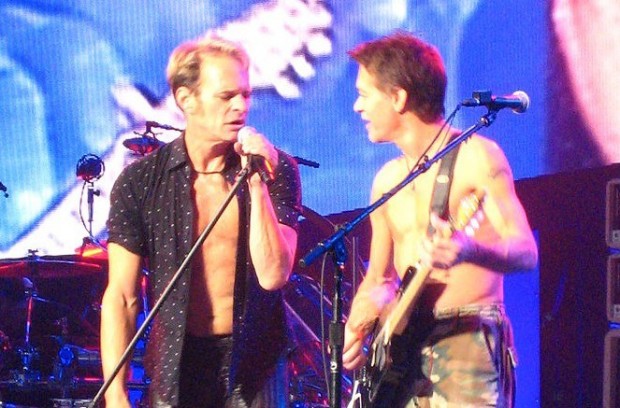
From Forbes.com:
By Ruth Blatt
Entrepreneurial skills aren’t crucial just for starting companies. They are crucial for initiating any creative commercial endeavor. A new biography argues that without the entrepreneurial skills of David Lee Roth, none of us would have heard of Van Halen.
Histories of Van Halen invariably begin in 1978, when the band released their debut album. Not much is known about the band before then other than that they had gotten their start playing back yard parties and moved up to playing clubs in Los Angeles.
That is about to change. Greg Renoff, an Associate Professor of History at Drury University and author of The Big Tent: The Traveling Circus in Georgia, 1820-1930, is writing a book about Van Halen’s early days.
Renoff explores in depth Van Halen’s reluctant journey from back yard band to superstardom and, in particular, the role of David Lee Roth’s ambition and entrepreneurial skills. Unlike the Van Halen brothers (Alex on drums and Eddie on guitar), Roth came from money. He owned amplification equipment, and he used it to work his way into the band.
“The Van Halens were always looking to scrounge equipment because they didn’t have a lot of money,” told me Renoff. “One thing that Roth did was use his PA system as leverage. He’d say things like, ‘You guys can use the PA system but how about I sing a song tonight?’” Eddie Van Halen was the band’s singer at the time, and even though he didn’t have a great voice, the band was not impressed by Roth’s vocal abilities either. But they eventually let Roth joined the band, which consisted of Eddie and Alex and bassist Michael Anthony, in 1973.
Roth’s presence stirred up the band. Whereas the Van Halen brothers were into heavy metal, Roth loved the Beach Boys, Motown and funk. “Those guys wanted to have Roth sing Black Sabbath, but Roth can’t sing Black Sabbath. He wanted to do things like James Brown’s ‘Cold Sweat.’” The outcome of this negotiation was a hard rock band with a pop sensibility.
Roth also began pushing the rest of the band to think beyond playing back yard concerts. According to Renoff, the Van Halens were content making good money playing shows in the Pasadena area that they would promote themselves for thousands of kids at a time. Roth pushed them to audition at clubs and expand their reach. He also pushed them to start dressing up. He wanted them to become rock stars, and for that they needed to look the part.
“They were wearing jeans and t-shirts, flannel shirts. It was grunge wear before grunge. They would wear Pendleton shirts and overalls,” said Renoff. “Roth told them they needed to glam it up, to wear stage clothes.”
Eventually they end up getting a gig playing in a Hollywood club called Gazzarri’s, which became the epicenter of hair-metal in the 1980s. “At the time Gazzarri’s was a dying club. Its moment had passed. It was much more of a 1960s go-go dancer place,” said Renoff. “But the owner, Bill Gazzarri, would advertise on a local radio station and they would say ‘Tonight at Gazzarri’s, Van Halen.’ Their name was on the marquee and it was a start for them.”
Gazzarri’s was a cover band club, not the kind of place where bands that write original songs get discovered and signed by record labels. Record executives look for bands that have an album’s-worth of original material. But at Gazzarri’s, Van Halen was expected to play disco songs and pop hits.
Yet Roth was a savvy networker and created opportunities where there were none. He would take advantage of the occasional visit to Gazzarri’s from people like radio DJ Rodney Bingenheimer and Kim Fowley, who managed The Runaways. Roth was a relentless self-promoter and got Van Halen on their radar. “I’m not saying the brothers were completely clueless about business, they weren’t,” said Renoff. “But Roth was the guy who was willing to get out front and promote, promote, promote. Of course they never would have made it without Eddie writing the songs and without their talents. But Roth was the guy who said, ‘Look at me!’”
Van Halen had original songs, and through Bingenheimer they got a gig playing their songs at the Starwood, a club owned by the infamous Eddie Nash. According to Renoff, the Van Halens were again hesitant about leaving their comfortable Gazzarri’s gig. But Roth convinced them to make the leap to a place where they could showcase their original material and play alongside bands like ZZ Top. It wasn’t long before a deal with Warner Brothers materialized.
David Lee Roth’s entrepreneurial spirit eventually rubbed off on the Van Halen brothers. In the early 1980s, Eddie Van Halen formed a relationship with Kramer Guitars to make the Eddie Van Halen Guitar and later he created the EVH brand that offers a complete line of guitar, guitar straps, amplifiers, strings and other gear.
“Eddie’s evolution is really interesting in that he went from a guy who was reticent about promotion, who didn’t want to dress up in stage clothes and who didn’t want to take risks to where now he realizes that you’re a business you have to market yourself,” said Renoff.
When David Lee Roth left Van Halen in 1985 to pursue a solo career, they replaced him with someone just as entrepreneurial: Sammy Hagar. Hagar founded the Cabo Wabo Tequila brand and restaurant chain, in partnership with the Van Halen brothers, as well as Sammy’s Beach Bar Rum, which he sold to Gruppo Campari for $91 million.
“By the 1990s, Van Halen had gotten religion about how to run a business,” said Renoff. Having an entrepreneur on their team from the start helped Van Halen turn their musical talent into a successful business.
Greg Renoff’s book, Van Halen Rising, will be published by ECW Press in 2015.